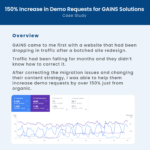Understanding the customer journey is essential for businesses looking to boost engagement and build loyalty. However, achieving a cohesive view is increasingly challenging, with customer interactions now spanning multiple channels and touchpoints.
Customers navigate a complex path, engaging with brands at various stages before making a commitment. As we look ahead to 2025, the transformative potential of AI in analyzing and enhancing the customer journey is set to reshape how organizations connect with their audiences. Up to 65% of customer experience leaders already view AI as an indispensable tool for creating richer interactions and securing a competitive edge.
Advanced insights into customer journey analytics
Through my experience working with various businesses, I’ve found that one of the biggest challenges isn’t just collecting data but interpreting it to drive actionable insights. Many organizations face fragmented data sources, creating a disjointed view of the customer journey and leading to missed engagement and personalization opportunities.
A common pitfall is the overreliance on vanity metrics like click-through rates and page views — figures that don’t necessarily reflect meaningful engagement. Shifting your focus to metrics that capture customer intent and satisfaction, such as conversion rates and customer lifetime value, can provide a clearer, more accurate picture of true engagement.
According to recent research, effective customer journey analysis and personalization can have a significant impact on a company’s success:
- 67% of brand leaders reported exceeding ROI expectations when brand messages were personalized and contextualized, per Gartner.
- 75% of consumers are more likely to purchase from businesses that offer personalized experiences, according to Accenture.
- Companies using customer journey analytics saw a 54% greater return on marketing investment than those without, the Aberdeen Group found.
- Organizations managing the entire customer journey achieved a 10-15% increase in revenue and a 20% increase in customer satisfaction, per a McKinsey & Company report.
These statistics underscore the tangible benefits that customer journey analysis can bring to a company’s bottom line.
Dig deeper: What marketers should know about customer journey analytics
Developing a customer engagement journey SaaS cloud platform and its impact
In helping develop Amazon Pinpoint and its analytics features, the insights gained from my patents were instrumental in addressing the widespread challenges faced in customer journey analytics. With over 80 citations, these patents underscore the significance of these issues and the industry’s ongoing efforts to find innovative solutions.
- Patent 1 introduces a novel approach to capturing and analyzing customer data across multiple channels, enabling businesses to identify key touchpoints and optimize engagement strategies.
- Patent 2 focuses on integrating AI and machine learning to predict customer behavior, allowing businesses to anticipate needs and personalize interactions in real time.
- Patent 3 addresses the challenge of data privacy and compliance, providing solutions for secure data handling and ensuring customer trust.
These patents reflect the evolving landscape of customer journey analytics, where cloud computing, AI/ML and emerging technologies like OpenAI drive the development of more sophisticated solutions. As the field advances, these innovations are helping businesses create highly personalized and engaging customer experiences, setting new standards for the industry.
Real-world challenges and solutions
One of the major hurdles I’ve encountered is integrating data from various channels to create a unified customer profile. Achieving this requires robust technology and a cultural shift within the organization — breaking down silos and fostering collaboration across departments. I’ve observed that companies that succeed in this area often implement cross-functional teams dedicated to customer experience, ensuring that insights are shared and acted upon throughout the organization.
Another significant challenge is ensuring data privacy and compliance, particularly with regulations like GDPR and CCPA. Businesses must be transparent about their data collection practices and prioritize ethical data handling to maintain customer trust. This is not just a legal obligation but a foundational element in building long-term, meaningful customer relationships.
Innovative approaches and future trends
Looking ahead, the integration of AI and machine learning into customer journey analytics is poised to revolutionize how businesses engage with their customers. These technologies offer real-time insights and predictive capabilities, enabling businesses to anticipate customer needs and tailor their strategies accordingly. For example, AI can identify when a customer will likely abandon a shopping cart and trigger personalized offers to encourage purchase completion.
Additionally, emerging technologies like augmented reality (AR) and the Internet of Things (IoT) present new opportunities for engagement, providing immersive and interactive experiences that can further enhance the customer journey.
Dig deeper: Customer journey orchestration. What is it and how does it work?
Best practices for using customer journey analytics
Creating exceptional customer experiences is crucial. About 91% of customers are more likely to make repeat purchases after a positive experience, and 71% base their purchase decisions on the quality of that experience, a recent Salesforce survey reveals.
Here are some best practices to effectively harness customer journey analytics and drive these outcomes.
- Identify key customer touchpoints: Pinpoint where your brand interacts with customers, both online and offline, to focus on areas that need crucial improvements.
- Map the customer journey: Create a visual representation of the customer journey, emphasizing key touchpoints, pain points and opportunities for enhancement.
- Collect and analyze data: Use tools such as website analytics, customer feedback surveys and call center transcripts to gather valuable data and identify areas for improvement.
- Test and iterate: Implement methods like A/B testing to evaluate the effectiveness of new solutions and make necessary adjustments based on the results.
- Involve stakeholders: Foster collaboration across departments to ensure a unified approach to enhancing the customer experience.
Conclusion
Customer journey analytics is a powerful tool that enables businesses to transform data into actionable insights, driving meaningful engagement and business growth. By addressing challenges such as data integration and privacy and using advanced technologies, businesses can create personalized experiences that resonate with customers. In today’s competitive landscape, as customer expectations continually evolve, journey analytics provides a roadmap for success, fostering loyalty and driving long-term business success.
The post How advanced customer journey analytics is shaping the future of engagement appeared first on MarTech.







